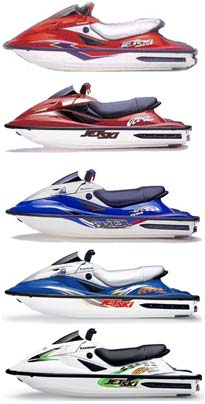
 About
the 99-2000 boats
About
the 99-2000 boats
It should be understood that Kawasaki, like all other pwc manufactures, try’s their very best to maintain the best possible level of overall performance consistency among their production machines. However the Ultra, like many other pwc muscle crafts, uses component designs that are pressed to the outer limits of their efficiency and design capabilities. This results in two problem areas: 1) Any component that is in less than optimum condition can significantly deteriorate performance, and 2) There is not a huge measure of performance ability “left on the table” using the stock components.
Production Variations – It goes without saying that there will always be some performance variations that result from production line manufacturing. As any machine relies on advanced design components to make it’s performance, the subtle variations in those components can affect performance of the whole unit. The following are the most common variations (we have proven so far) that can have an effect on the true speed ability of any particular Ultra.
Hull – In the same sense that elite athletes are often a product of random “good genes”, so too are particularly fast Ultras often a product of randomly good hulls. This does not say that any Ultra hulls are bad, but rather that some a measurably above par. We tend to think that this may be a function of how the Ultra hulls rely so much on high-speed lift in order to attain true peak speeds. We refer to the Ultra’s long, slow acceleration to peak speed as “crawl time” (literally the time it takes the boat to crawl up to peak rpm and peak radar speed). Our considerable on-water testing has led us to believe that this long crawl time is more a function of the hull than anything else. That is, the Ultra hull does not completely get up out of the water until speeds have gotten quite high. As the speeds slowly increase, the hull lifts slightly higher out of the water, which allows slightly more speed … and so on. To be sure, the goal of most modifications is to reduce this crawl time, however on very smooth water conditions it will always exist to some measure. The exceptionally fast hulls that we have seen not only go slightly faster, but also they typically have shorter crawl times as well.
Props – The Kawasaki parts books show only one part number for the ’99-’01 stock Ultra impeller. Referencing any pitch numbers to this prop is a complete waste of time. The stock Ultra prop has blades that are curved on three planes, most of which are not measurable with any of the normal pitch gauges. In addition, the stock Ultra prop has the thinnest blades of any OEM prop we have ever seen. The 3-D blade contours and thin blade material is another example of design pushed to the outer limits to optimize a part. If the thin blades of the Ultra prop are subjected to even the slightest rock damage, overall speed and performance suffer heavily.
Pump Bearings – Since the Ultra pump utilizes a tapered diameter prop that is shimmed closely to a similarly tapered housing, the Ultra relies heavily on excellent condition pump bearings to maintain optimum impeller to housing clearance. If there is any part of a high output Ultra that might be considered a “weak link”, the front pump bearing and seal would be it. Even though the front bearing in the pump is a heavy-duty high quality sealed bearing, it can still allow some prop movement when subjected to the staggering loads of a high output Ultra operated at full loads. To date there is no way to remedy the wear that this abused bearing eventually takes. While solutions are being sought, the only current remedy (for Ultra owners wishing to get optimum performance) is to install a fresh bearing and seal regularly. In the case of high output Ultras that are operated in the most abusive way, replacement intervals of 15-20 hours are common. If a machine is operated with a worn bearing, the prop can move slightly forward to make physical contact with the impeller housing … resulting in sudden and significant speed loss. In many cases, a whining sound can be heard coming from the rear of the machine, indicating the failed bearing.